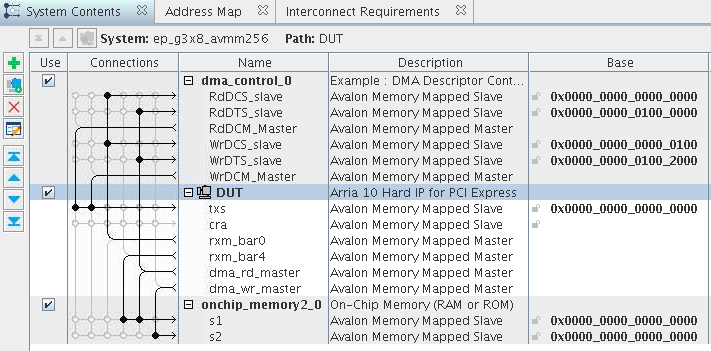Visible to Intel only — GUID: lbl1459876443020
Ixiasoft
1. Datasheet
2. Getting Started with the Avalon-MM DMA
3. Parameter Settings
4. Physical Layout
5. IP Core Interfaces
6. Registers
7. Reset and Clocks
8. Error Handling
9. PCI Express Protocol Stack
10. Arria® 10 or Cyclone® 10 GX Avalon-MM DMA for PCI Express
11. Design Implementation
A. Transaction Layer Packet (TLP) Header Formats
B. Arria® 10 or Cyclone® 10 GX Avalon-MM DMA Interface for PCIe Solutions User Guide Archive
C. Document Revision History
1.1. Arria® 10 or Cyclone® 10 GX Avalon-MM DMA Interface for PCIe* Datasheet
1.2. Features
1.3. Comparison of Avalon-ST, Avalon-MM and Avalon-MM with DMA Interfaces
1.4. Release Information
1.5. Device Family Support
1.6. Design Examples
1.7. IP Core Verification
1.8. Resource Utilization
1.9. Recommended Speed Grades
1.10. Creating a Design for PCI Express
5.1. Arria® 10 or Cyclone® 10 GX DMA Avalon-MM DMA Interface to the Application Layer
5.2. Clock Signals
5.3. Reset, Status, and Link Training Signals
5.4. MSI Interrupts for Endpoints
5.5. Hard IP Reconfiguration Interface
5.6. Physical Layer Interface Signals
5.7. Test Signals
5.8. Arria® 10 Development Kit Conduit Interface
5.1.1. Avalon-MM DMA Interfaces when Descriptor Controller Is Internally Instantiated
5.1.2. Read Data Mover
5.1.3. Write DMA Avalon-MM Master Port
5.1.4. RX Master Module
5.1.5. Non-Bursing Slave Module
5.1.6. 32-Bit Control Register Access (CRA) Slave Signals
5.1.7. Avalon-ST Descriptor Control Interface when Instantiated Separately
5.1.8. Descriptor Controller Interfaces when Instantiated Internally
6.1. Correspondence between Configuration Space Registers and the PCIe Specification
6.2. Type 0 Configuration Space Registers
6.3. Type 1 Configuration Space Registers
6.4. PCI Express Capability Structures
6.5. Intel-Defined VSEC Registers
6.6. Advanced Error Reporting Capability
6.7. DMA Descriptor Controller Registers
6.8. Control Register Access (CRA) Avalon-MM Slave Port
Visible to Intel only — GUID: lbl1459876443020
Ixiasoft
10.2. Understanding the External DMA Descriptor Controller
Using the External DMA Descriptor Controller provides more flexibility. You can either modify or replace it to meet your system requirements.You may need to modify the DMA Descriptor Controller for the following reasons:
- To implement multi-channel operation
- To implement the descriptors as a linked list or to implement a custom DMA programming model
- To store descriptors in a local memory, instead of system (host-side) memory
To interface to the DMA logic included in this variant, the custom DMA descriptor controller must implement the following functions:
- It must communicate with the Write Mover and Read Mover to copy the descriptor table to local memory.
- The Write Mover and Read Mover must execute the descriptors stored in local memory.
- The DMA Avalon-MM write (WrDCM_Master) and read (RdDCM_Master) masters must be able to update status to the TX slave (TXS).
Figure 52. Avalon-MM DMA Block Diagram with External DMA Descriptor ControllerThis Platform Designer design example, ep_g3x8_avmm256.qsys, is available in the <install_dir>/ ip/altera/altera_pcie/altera_pcie_a10_ed/example_design/a10 directory. This screen capture filters out some interface types for clarity.


Figure 53. Avalon-MM DMA Block Diagram with External DMA Descriptor ControllerThis block diagram corresponds to the Platform Designer system shown in the previous figure. When the DMA Descriptor Controller is instantiated as a external component, it drives table entries on the RdDmaRxData_i[159:0] and WrDmaRxData_i[159:0] buses.
The DMA modules shown in the block diagram implements the following functionality:
- Read DMA (Read Mover and dma_rd_master) –Transfers data from the host domain to the local domain. It sends Memory Read TLPs upstream and writes the completion data to external Avalon-MM components using its own high performance master port. It follows the PCI Express Base Specification rules concerning tags, flow control credits, read completion boundary, maximum read size, and 4 KB boundaries.
- Write DMA (Write Mover and dma_wr_master) – Transfers data from the local domain to the host domain. It reads data from an Avalon-MM slave component using its own high performance master port. It sends data upstream using Memory Write TLPs. It follows the PCI Express Base Specification rules concerning tags, flow control credits, RX buffer completion rules, maximum payload size, and 4 KB boundaries.
- DMA Descriptor Controller–Manages read and write DMA operations. Host software programs its internal registers with the location of the descriptor table residing in the PCI Express system memory. The descriptor control logic directs the DMA read logic to copy the entire table to the local FIFO. It then fetches the table entries from the FIFO one at a time. It directs the appropriate DMA to transfer the data between the local and host domains. It also sends DMA status upstream via the TX slave single dword port (TXS). For more information about the DMA Descriptor Controller registers, refer to DMA Descriptor Controller Registers.
- RX Master (PCIe BAR0-1) –Allows the host to program internal registers of the DMA Descriptor Controller.
- TX Slave (TXS) – The DMA Descriptor Controller reports status on each read and write descriptor to this Avalon-MM slave. It also uses this port to send MSI requests.